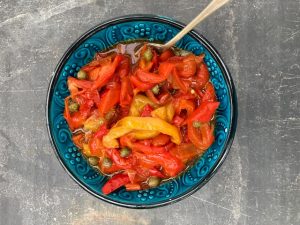It’s been an amazing summer in the greenhouse for peppers, aubergines and anything Mediterranean. What these crops need in order to produce at their best is warmth and lots over it over a long period of time, and they certainly got that. So much so that the challenge this year was cooling down the greenhouse: windows and doors open every day, of course, but I also put up thicker shading than usual and wetted down the floor and bench several times a day whenever I was around, to prevent the greenhouse from overheating and the plants from being scorched. The result though, is a bumper crop of all of the most luxurious vegetables: they are worth the trouble. I hesitate to call it a glut – I have never yet produced more of these greenhouse vegetables than I can eat, partly because my greenhouse is relatively small, partly because I eat them so often. But there are plenty, and this is the moment in the year to dig out your pepper recipes.

In truth though, the thing I make most often with peppers is barely a recipe at all. In writing this I have looked up ‘peperonata’, which is what I thought I had been making all this time, and find that my version has strayed over the years. Peperonata, it turns out, generally comprises a mess of sliced onion and strips of pepper, fried in olive oil with garlic and tomatoes to make a stew. Mine is a bit more pared back, but I am delighted to find that there are a great number of variations from around Italy, and that mine corresponds pretty closely with the way the people of Naples make theirs. I’ll now be able to pretend that was what I intended all along. I (along with the Neopolitans) slice my peppers, season them with salt and fry them in olive oil until soft and slippery and perhaps a little caramelised at the edges. I then tip in a couple of forkfuls of capers and stir them in. Often I will also add a slosh of red wine vinegar and stir everything in (I am told that the addition of red wine vinegar is more Roman than Neopolitan. I knew that, of course…). And that’s it. Eat immediately or leave to cool and eat at room temperature, when the flavours are even better. Eat piled on top of a burrata, along with spoonfuls of the juices and a hunk of bread to soak them up, or in a mezze with olives, braised artichokes and stuffed vine leaves, or in a toasted pitta bread with hummus, stirred into pasta sauce, or any other number of ways. It’s a good way of turning a big pile of vegetables into something that you want to dip into and eat every day.
In some areas, fried breadcrumbs, parsley and garlic are added, in others anchovies. Caponata is very similar, but with aubergines, onions and tomatoes as well as the peppers, cut up small and fried until soft and caramelised. You can also cut up boiled potatoes and stir them into the mix while everything is still hot, and add a big glug of vinegar and plenty of salt. It is all delicious, and what good bread was made for.
There is certainly no excuse to be overwhelmed by a glut of peppers, aubergines and tomatoes. This is one of the best months of the year for eating from the greenhouse, and it wont last for long, so enjoy those glossy beauties – swimming in lashings of extra virgin olive oil – while you still can.


